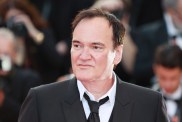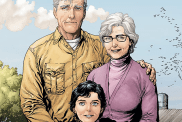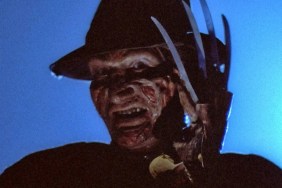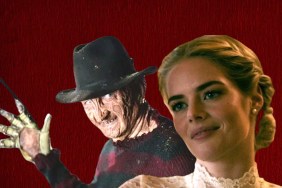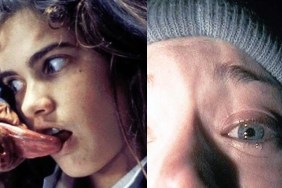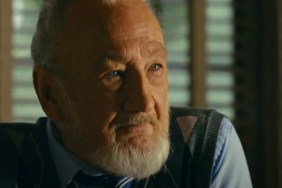
Writer M-E Girard pens a personal account of her relationship with A NIGHTMARE ON ELM STREET 5: THE DREAM CHILD.
In or around 1994, there was this: a twelve-year-old French-Canadian kid, a 13-inch TV-VCR combo set, and a copy of A NIGHTMARE ON ELM STREET 5: THE DREAM CHILD. It was likely a Saturday afternoon, a great time to clean and organize my room. If I wasnt done by the time Alice and Yvonne gushed over baby Jacob in the Freddy-free park, Id Stop and Rewind right back to Dans and Alices undulating bodies in blue-filtered shots that I was never quite sure contained nudity or not.
I spent an embarrassing number of weekends this way, hanging out with the 1989 group of Elm Street teens. Their dialogue was my dialogue. The gang bantering in their caps and gownsa pretty benign exchange of lineswas one of my favorite moments to join in on. The whole lets-feed-Greta-to-death scene? Had it down. And of course, Amanda Kruegers Your birth was a curse on the whole of humanity speech was simply epic. I got closer to the TV at that part to deliver my lines.
The Nightmare movies entered my life by way of Parisian-dubbed, late-night TV programming (un, deux, voila Freddy laffreux ). Before Five, Four had made the most impression on me, largely due to Lisa Wilcoxs portrayal of Alice.

I was twelve-ish but something made this film stupidly rewatchable for me. Back then, had you asked me what it was about this movie that made it The One, I think my answer wouldve gone a little like this: I dont know. Its just so good. The people, and like, the story. Watch it, and if you dont like it, then I guess you suck.
At thirty-two-ish now, and being a fiction writer, Ive gotten better at articulating my thoughts, or at least, I have more words to work with. But it turns out I had it right back then: It really is as simple as the people, and like, the story.
The element of storytelling that I connect with and respond to the most is characterization. Give me a movie about a group of friends and show me who they are, how they relate to the world and each othereven if the plot is super low-keyIll be transported. Of course I can appreciate something thats high-concept, plot-driven, something thats flashy, thats aesthetically pleasing, or that has a rhythm.But ultimately, its the people.The Dream Child gives me a group of young adults I care aboutfronted by a lead I was already willing to follow anywhere. A group of people I wantedand still wantto be friends with (maybe cyber friends, far away from Elm Street). I trusted that the Elm Street movies were going to keep delivering a central group of young characters that I was going to root for; Dream Warriors and The Dream Master had established this for me already. Alices character arc was taking her places that I felt were authentic, and I identified with her, I understood her, I admired her.

THE DREAM CHILD gave me people to pay attention to, who were more than what they appeared to be on the surface: a loyal comic book nerd waiting for his moment to kick ass; a disciplined, bossy girl who had to open her mind and relinquish control in order to get the job done; a supermodel-in-training who couldve gone places, except the only place she wanted to go was wherever was going to be farthest from her mothers relentless cloud of pressure; and, of course, the girl whod finally risen above tragedies of the past, only to have it all ripped away in exchange for something she didnt want but now had to fight like hell to savenot only from supernatural evil, but from those insufferable adults who always think they know best. If youre thinking character cliché, which is something the movies been criticized for, Ill argue that summing up a life in a few words always turns it into a cliché. These characters were believable, unique, and their characterization, coupled with the actors performances, made their journeys compelling. It sucked when members of the gang were offed, no matter how imaginative the kill scenes were.
I was hooked on the Elm Street movies dream-world transition scenes. In The Dream Child, my first trip to Freddys playing field began with Alice plunging her fingers into the shower drain to see what nasty gunk mightve been blocking it, and I watched as the thing first sputtered with baby-puke-like sludge, then the entire shower filled with water.
Of course, there are the one-liners, the odd dream sequences, the insight into Freddy Kruegers past. There are visually pleasing scenes such as when Alice clutches on to a mangled Greta who suddenly appeared in the refrigerator, and when an eviscerated doll lies on a dinner platter. Mysterious, sad-eyed Jacob appearing to Alice and eventually being revealed as being a projection of her unborn babythis is what gave the movie substance.
This movie dealt with a myriad of issues: teen pregnancy, drinking and driving, eating disorders, and parental pressure to name a few. One of my favorite moments was watching the set-up as Alices doctor and Dans parents did their best to convince her she was crazy and needed to give up her baby, and being there when Alice stood up for herself, prompting her father to snap out of his subdued state and stand behind her. Lisa Wilcox was quoted in an interview as saying this was perhaps too much for a Nightmare film to handle. Its difficult for me to know if I should agree here or not, as Im not a knowledgeable movie critic, nor am I a connoisseur of the horror genre. Im just a run-of-the-mill Freddy fan, but that also means I was the intended audience for the film, and to anyone who criticizes it or fails to see its brilliance, I have this to say: If you dont like it, then I guess you suck…

